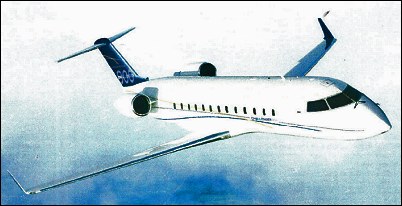 |
Bombardier CRJ-200 / Challenger 8001991 |  |
| PASSENGER | Virtual Aircraft Museum / Canada / Bombardier |
 |
Design studies began in third quarter of 1987; basic configuration frozen June 1988; formal programme go-ahead given 31 March 1989; extended-range CRJ100ER announced September 1990. Three development aircraft built, plus static test airframe and forward fuselage test article; first flight 10 May 1991; Transport Canada type approval (CRJ100 and CRJ100ER) 31 July 1992. Japanese Civil Aviation Bureau certification 23 May 2000. First delivery aircraft flew 4 July 1992, and to Lufthansa Cityline of Germany 29 October 1992; European JAA and US FAA certification 14 and 21 January 1993 respectively; long-range CRJ100LR certified 29 April 1994; CRJ200 with CF34-TB1 engines announced in 1995. Replaced CRJ 100 after 226 of the latter had been delivered. 200th aircraft delivered (to Lufthansa) 24 October 1997; 300th to Atlantic Coast Airlines in April 1999. 400th to Delta Connection/Sky West in July 2000. 500th to Atlantic Coast Airliners 26 April 2001, and 600th to Atlantic Southeast Airlines 29 January 2002, and 700th to Air Nostrum 30 October 2002. Production of CRJ200 running at 9.5 per month in 2000, rising to 12.5 per month by late 2001, and 14.5 per month by 2003, with annual targets of 165 in 2003 and 174 in 2004. VERSIONS CRJ -100: Original standard aircraft. Engineering designation CL-600-2B19. CRJ-100ER: Replaced by CRJ200ER. CRJ-100LR: Announced March 1994; launch customer, Lauda Air of Austria: replaced by CRJ200LR. CRJ-200: Standard aircraft; designed to carry 50 passengers over 1,824km range; CF34-3B1 engines with 2.8 per cent lower specific fuel consumption than CF34-3A1 of CRJ100, increasing initial cruise altitude by 213m, cruising speed by 4.5km/h, and range typically by 1.5 per cent; Class C baggage compartment as standard. First delivery. to Tyrolean Airways, 15 January 1996. CRJ-200ER: Extended-range capability with optional increase in maximum TO weight to 23,133kg and optional additional fuel capacity, for range of 3,046km. CRJ-200LR: Longer-range version of CRJ200ER (more than 3,713km; maximum T-O weght increased by 907kg to 24,040kg. CRJ-200B, CRJ-200B ER and CRJ-200B LR: As above, but with optional hot-and-high CF34-3B1 engines. CRJ-440 : Engineering designation CL-600-2B19. Version seating 44 passengers in standard configuration. Launch customer Northwest Airlines has ordered 75. CRJ-700: Described separately. Corporate Jetliner: Company shuttle version with more spacious cabin accommodation for 18 to 30 passengers. One delivered June 1993 to Xerox Corporation. Five ordered by the People's Republic of China in January 1997. Supplanted from September 2002 by corporate version of Challenger 800. Challenger 800: Corporate version developed in consultation with launch customer TAG Aeronautics Ltd to meet requirement for non-stop flights, London to Jeddah or equivalent, with three crew and five passengers; or between Middle East city pairs with 15 passengers. First flown 26 May 1995 and formally announced at Paris Air Show in the following month; initially designated Canadair Special Edition; first delivery to TAG during Dubai International Aerospace Show in November 1995. Accommodation for up to 19 passengers in customised cabin; additional 1,814kg of fuel carried in two auxiliary tanks behind main cabin, extending range to more than 5,556km; maximum T-O weight 24,040kg; first aircraft powered by standard CF34-3A1 turbofans, but subsequent examples are equipped with CF34-3B1s increasing range to 5,778km. Manufactured to special order only. Recent customers include Poly Technologies lnc, which ordered two on 16 August 2001 for operation by China Ocean Aviation Group, with deliveries scheduled for 2002.
|  COMPANY PROFILE | |||||||||||
 |

|


 dafacai
dafacai
20
reply